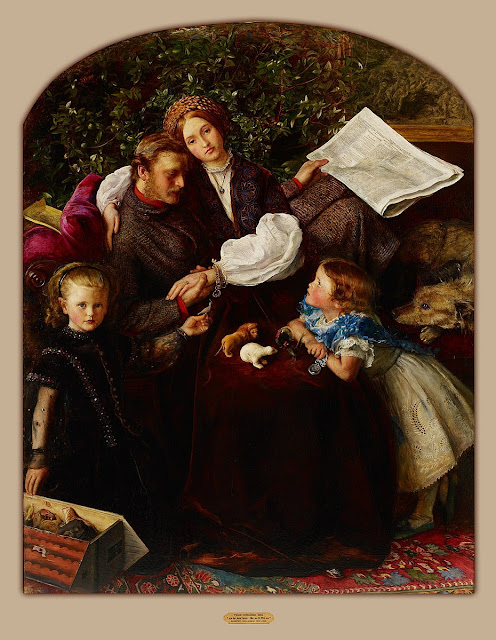Peace Concluded by John Everett Millais (Interpretation and Analysis)
 |
| Peace Concluded Source: Wikimedia Commons |
When considering Millais’ vast oeuvre, it would be difficult to find a painting more beautiful or more serene than Peace Concluded.
The painting depicts a wounded British army officer, who is surrounded by his family as he reads about the end of the Crimean War in the newspaper. His wife rests on the sofa with him, presumably sharing in the good news of peace. Two children play with animal figurines in front of their parents. One little girl holds a toy dove—a symbol of peace—while the other child seems to be playing with a rooster, a lion, a bear, and a turkey on her mother’s lap. Each one of these animals symbolize a different participant in the conflict.
Originally, Millais intended the painting to be satirical, a criticism of officers who returned home to relax while common soldiers continued to fight. However, with the advent of peace, he revised his vision. In its final version, Peace Concluded is a paean to the ideal Victorian home and family.
The Victorians were obsessed with the idea of home, and they idolized family life. To them, their English homes were the heart of their far flung empire, a place of safety and happiness that functioned as both a reward and a refuge from the difficult labor of empire building. In fact, the existence of the empire itself can be seen as a way for the Victorians to support their tranquil and comfortable English homes. According to my research, the members of the painted family symbolize the values at the core of this worldview: loyalty and fidelity to their country, their empire, and each other. The sacrifice of the army officer—the father of the family—is especially lionized. He is a virtuous Victorian gentleman, a protector of both his family and his nation. The viewer should celebrate his sacrifice.
However, the painting may have also had a more personal meaning for Millais. He created Peace Concluded shortly after his marriage to Effie Gray, who modeled for the officer’s wife in the painting. Up until this point, Millais and Gray’s relationship was fraught. Gray was married to John Ruskin when she met Millais. Their marriage was unhappy and traumatic for Gray, and, although she eventually obtained an annulment, the experience left her emotionally fragile and shaken. The uncertainty and drama surrounding her relationship with Ruskin was equally stressful for Millais, and the early stages of their new relationship were far from easy.
After their marriage, however, Millais and Gray quickly found happiness together. Peace Concluded can be seen as a celebration of Millais’ newfound domestic tranquility. After a protracted emotional and legal storm, the couple had finally found peace together.
Gray’s serene face gives credence to this theory. She presides over the other figures in Peace Concluded with calm dignity, and she is easily the focal point of the painting. Painted with her distinctive hairstyle, Millais made no attempt to conceal his wife’s identity in the piece. Rather, she seems to be a personal symbol for the artist: the embodiment of peace, love, and domestic happiness.



Comments
Post a Comment